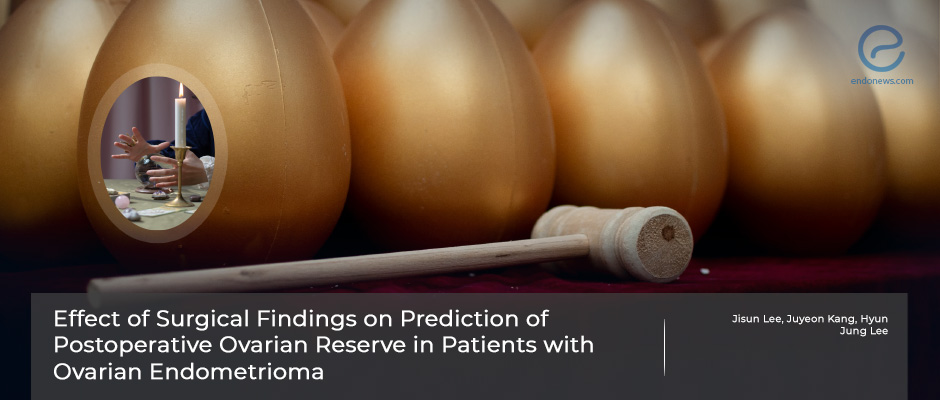The predictive value of operative findings concerning ovarian reserve
Sep 16, 2022
What to expect from the operation findings when talking about postoperative ovarian reserve
Key Points
Highlights:
- The study shows the importance of endometrioma size, depth, and adhesions in order to list the predictors of postoperative AMH levels.
Importance:
- Using a prediction model, it may be possible to assess the AMH alterations to give information to the patients.
What's done here:
- This study evaluated the relationship of surgical findings with the postoperative serum Anti-Müllerian hormone (AMH) alterations in endometriosis.
- 112 patients with ovarian endometrioma underwent ovarian cystectomy over a 7-year-old period were retrospectively evaluated.
- rASRM scores, depth, and size of the endometrioma, extension of adhesions were noted, and 3 scores were defined:
- The endometrioma score, (the sum of the scores for the size and depth of ovarian endometrioma)
- The adhesion score (the sum of the scores for the extent and types of ovarian adhesions)
- Ovarian score: the sum of the endometrioma score and adhesion score.
- AMH levels were checked in each patient before surgery (AMH0) and 3 (AMH3) and 6 (AMH6) months after surgery.
Key Results:
- AMH levels declined more in patients who had surgery rASRM stage IV.
- The ovarian score was correlated with the ratio of AMH6/AMH0 (p = 0.001).
- The UPV has been found to be correlated with ovarian score negatively.
- The pAMH6 was found to be reflecting AMH6 and showed a decline with age.
- The pAMH6 showed a sensitivity of 0.564, specificity of 0.909, positive predictive rate of 0.786, and negative predictive rate of 0.800 in the prediction of PORG (p < 0.001).
Limitations:
The retrospective nature of the study limits to description effects of complementary variables and also there is no data about antral follicle counts and FSH-estr
Lay Summary
Having endometrioma is a proven factor that affects the ovarian reserve of patients with endometriosis. Not only its presence but also the surgery applied, and concomitant disease stage might affect the reserve.
In this retrospective analysis conducted in Korea by Jisun Lee et al, the researchers questioned the factors affecting postoperative ovarian reserve on endometrioma surgery.
They analyzed 112 patients with ovarian endometrioma who underwent ovarian cystectomy over a 7-year-old period. rASRM scores, depth, and size of the endometrioma, and extension of adhesions were noted, and 3 scores were defined: The "endometrioma score" (the sum of the scores for the size and depth of ovarian endometrioma), the "adhesion score" (the sum of the scores for the extent and types of ovarian adhesions), and the sum of the endometrioma score and adhesion score, defined as the "ovarian score".
AMH levels were checked in each patient before surgery and 3 and 6 months after surgery. An unstandardized predictive value was obtained by multiplying several calculations.
AMH levels declined more in patients who had surgery rASRM stage IV. The ovarian score has been found to be correlated with the ratio of AMH6/AMH0 (p = 0.001). The UPV has been found to be correlated with ovarian scores negatively. The pAMH6 was found to be reflecting AMH6 and showed a decline with age. The pAMH6 showed a sensitivity of 0.564, specificity of 0.909, positive predictive rate of 0.786, and negative predictive rate of 0.800 in the prediction of PORG (p < 0.001). While its retrospective nature limits the sensitivity results it gives a good insight into the perioperative prediction of postoperative AMH levels according to what we see.
The ovarian score was defined as the sum of the endometrioma score from the size and depth of endometrioma and the adhesion score from the extent and types of ovarian adhesion described in the rASRM classification. The ovarian score was correlated with the AMH levels before surgery (AMH0), 3 (AMH3), and 6 months (AMH6) after surgery. To design a model for predicting AMH6, using ovarian score and AMH0, we calculated the unstandardized predictive value of AMH6/AMH0 (UPV) by linear regression analysis. The predicted AMH6 (pAMH6) could be calculated by multiplying the UPV by AMH0. When AMH6 is less than 1.0 ng/mL, it was defined as a poor ovarian reserve group (PORG), and the accuracy of the predictive model was validated.
Results: The level of AMH declined more in rASRM stage IV compared to stage III after surgery. The ovarian score had a significant variable in the linear regression analysis with the ratio of AMH6/AMH0 (p = 0.001). The UPV was correlated with ovarian score negatively. The pAMH6 correlated with AMH6 positively and with age negatively. The pAMH6 showed sensitivity 0.564, specificity 0.909, positive predictive rate 0.786, and negative predictive rate 0.800 in the prediction of PORG (p < 0.001).
Conclusion: The pAMH6 predicted the PORG at 6 months after surgery. Based on the results of our study, the surgical findings, including the size and depth of the endometrioma and extent and types of adhesion could be useful indicators for ovarian reserve after surgery.
Keywords: anti-Müllerian hormone; cystectomy; endometrioma; ovarian reserve; revised American Society for Reproductive Medicine (rASRM) classification.
Research Source: https://pubmed.ncbi.nlm.nih.gov/36032056/
endometrioma AMH rASRM

